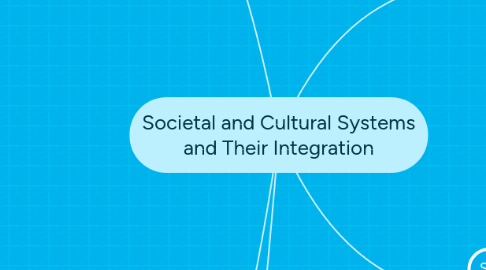
1. Theories
1.1. Linton
1.1.1. Classification of cultural items as
1.1.1.1. i. Universals
1.1.1.2. ii. Alternative
1.1.2. Advanced a hypothesis
1.1.2.1. Proportion of alternative
1.1.2.2. Degree of culture integreation
1.2. Sorokin
1.2.1. Developed 6 categories of integration
1.2.1.1. i. Unity based upon perception
1.2.1.1.1. - Spatially contagious
1.2.1.1.2. - Perceptual unities
1.2.1.2. ii. Casual - Functional unity
1.2.1.2.1. - Spatially contagious
1.2.1.2.2. - Mechanically cohesive unities
1.2.1.3. iii. Logico - Meaningful unity
1.2.1.3.1. - Indirect Casual
1.2.1.4. iv. Direct casual - Functional unities
1.2.1.5. v. Pure meaningful, logico - Aesthetic unities
1.2.1.6. vi. Integrate the level of concept
1.2.1.6.1. Level of phenomena
1.3. Landacker
1.3.1. Distinguished
1.3.1.1. i. Cultural integration
1.3.1.1.1. - Relations between cultural products in terms of consistency
1.3.1.2. ii. Normative integration
1.3.1.2.1. - Relations between cultural product & the behavior in terms of community
1.3.1.3. iii. Communicative integration
1.3.1.3.1. - Volume of communication between members of the group
1.3.1.4. iv. Functional integration
1.3.1.4.1. - Describe the number of services exchanged between the members
1.4. The Three catogories
1.4.1. i. Spatial category of societal phenomena
1.4.2. ii. Time category of cultural items
1.4.2.1. Actualized by a person
1.4.3. iii. Spaceless-timeless category of the system of culture
1.4.3.1. link to category of space
1.4.3.1.1. means to category of validity
1.4.3.2. link to means of the category of causality-teleology
1.4.3.2.1. succesiveness
1.5. Four possible modi
1.5.1. Following fourfold table expressed
1.5.1.1. 1. If cells number 1 and 2
1.5.1.1.1. It represents the most integrated group in the both system
1.5.1.2. 2. If cells number 1 and 4
1.5.1.2.1. It represents a group which is socially organized but cultural system displays contradiction
1.5.1.3. 3. Connection of cells number 2 and 3
1.5.1.3.1. A case which persons have same values but unable to carry out a coordination action.
1.5.1.4. 4. Cells number 3 and 4
1.5.1.4.1. Case of maximum social and cultural disorganization.
1.5.2. - A maximal integration
1.5.2.1. in relations between concepts and phenomena
1.5.3. societal and cultural self-awareness
1.5.3.1. - Produced awareness of certain contradictions
1.5.4. Similarity of societal and cultural pattern :
1.5.4.1. - Tend to be integrated in term of both spatial and time dimensions
1.5.5. Difference
1.5.5.1. - Cutural system = abstract system
1.5.5.2. - Societal pattern = concrete action system
1.5.5.2.1. - Concrete system is characterized by
1.5.6. Culture = conceived on the level of potentialities
1.5.6.1. - Capacity of human to manipulate future
1.5.6.2. - Past activities by means of symbols
1.5.7. Culture = transcendental category
1.5.7.1. Overlaps with society but simultaneously transcends it.
2. Concept
2.1. Society prior to cultural
3. Schools of thought
3.1. Emile Durkheim
3.1.1. System culture = Collective representations/ Social facts
3.2. Radcliffe-Brown
3.2.1. Social structure = an abstraction
3.3. Talcott Parsons
3.3.1. Prefer that :
3.3.1.1. i) social system + system of person= concrete action
3.3.1.2. ii) culture= an abstraction
3.3.2. Stressed aspect of culture
3.3.2.1. Mutual relationship
3.3.2.1.1. i. Timeless
3.3.2.1.2. ii. Spaceless
3.4. Znaniecki
3.4.1. - Culture depend actual interaction
3.4.1.1. values influences
3.4.1.1.1. interaction of persons
3.4.2. - Social system
3.4.2.1. a part
3.4.2.1.1. cultural system
3.4.3. - Conceived culture that area of reality created by man
3.4.3.1. characterized:
3.4.3.1.1. group of behavior = product of man
3.4.4. Concept of culture and social structure
3.4.4.1. i. Time
3.4.4.2. ii. Space
3.4.5. Idea of a person
3.4.5.1. when they are interact each other among themselves
3.4.5.1.1. characteristic of actualization
3.4.6. Idea of a group of people
3.4.6.1. characteristic determine by spatial dimension symbolism
3.4.6.1.1. analysis bring out
3.5. B. Barber
3.5.1. Concerned social structure and culture
3.5.1.1. - Necessary functional components
3.5.1.2. - Simultaneously interdependent
4. Societal and Cultural integration
4.1. Characterized by :
4.1.1. i. Achieved within the category of meaningful consistency
4.1.2. ii. Situation :
4.1.2.1. - Actor succeeds
4.1.2.1.1. Compartmentalizing particular values
4.1.2.2. - Actor confronts and eliminates
4.1.2.2.1. Contradictory persons
4.2. Confrontation of Values
4.2.1. values transferred from the category of time to the category of spaceless-timeless validity
4.2.1.1. (transferred form dimension of successivity to dimension of simultaneity)
4.3. Well-integrated social system characterized by
4.3.1. i. A dynamic equilibrium
4.3.2. ii. Simultaneous coordination of all functions
4.3.3. iii. Capacity to meet unexpected situations
5. Summary :
5.1. Define :
5.1.1. Concepts social structure
5.1.1.1. i. Time dimension
5.1.1.2. ii. Space dimension
5.2. Societal phenomena
5.2.1. - Developed along the dimension of space
5.2.2. - Organized on basis of causality-teleology
5.2.3. - Cultural items originate primarily within the dimension of time
5.3. Integration of culture
5.3.1. Based on :
5.3.1.1. Principle of validity-consistency
5.3.1.1.1. - Imposed upon the former successive compartmentalization of cultural items
5.4. Well-integrated social structure and culture
5.4.1. Both culture and social structure developed along both dimensions
5.4.1.1. i.e. time and space
5.5. Social-cultural system
5.5.1. Defined as :
5.5.1.1. of relations which must be :
5.5.1.1.1. i. Coordinated
5.5.1.1.2. ii. Consistent
